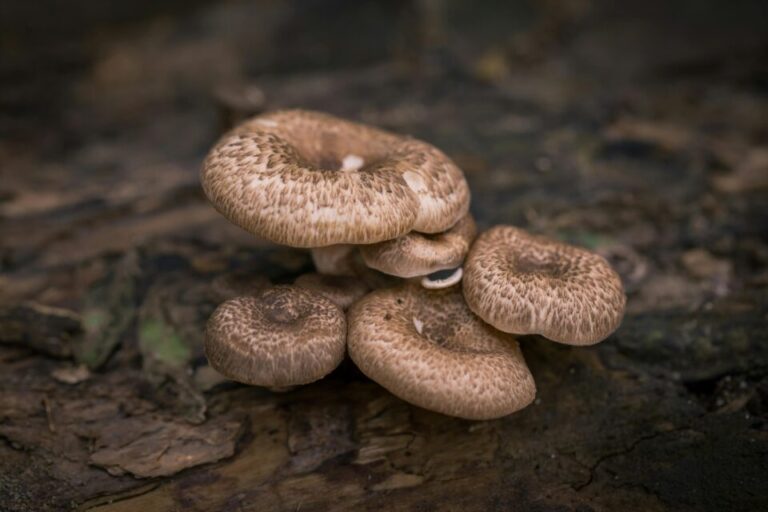You can ask whether mushrooms are heterotrophs or autotrophs. First, recognize that all living things require energy to survive and the sun is the major source of that energy. Only plants, however, can directly harness the sun’s energy to produce food. This suggests that mushrooms are heterotrophic.
In this article, we’ll give you an answer to the question, “Is a mushroom an autotroph?” Discuss why mushrooms aren’t autotrophic and other information that might interest you.
Is a Mushroom an Autotroph?
No, a mushroom is not an autotroph. They are at the second trophic level, feeding on organic matter.
Unlike green plants, mushrooms do not require pigments to photosynthesize. This means they are not autotrophs and cannot use the sun’s energy to produce food.
Why aren’t mushrooms autotrophic?
Unlike green plants, mushrooms do not require pigments to photosynthesize.
It is mostly due to a lack of chlorophyll, the green pigment found in green plants and the inability to manufacture it.
Are Fungi Heterotrophs?
Fungi are eukaryotes, which means they cannot photosynthesize and must get their energy from organic matter.
Instead, they create exoenzymes, which degrade big molecules like carbohydrates, proteins and lipids. Fungi cells then uptake these enzymes.
Fungi are a very varied group of creatures. They range in size from tiny to large fruiting bodies and dwell underground in a variety of settings.
They are closely related to plants but significantly different, making them valuable ecosystem components.
Heterotrophs are plants that feed on live organisms. They feed on other species and contribute to the breakdown of organic substances.
As a result, they are required for a variety of domestic procedures, including bread baking and cheese production. Additionally, they function as decomposers and recycle nutrients in the environment.
How Are Mushrooms Heterotrophic?
Heterotrophs are plants that can convert organic compounds into energy. They also degrade other molecules, like proteins and nucleic acids and integrate them into bodies.
The end outcome is food for both their cells and the body. As a result, mushrooms are classified as heterotrophic.
Decomposition describes the mechanism by which mushrooms obtain energy. These organisms use enzymes to break down complex organic molecules and consume the resultant soup.
Carbon and other nutrients can also be obtained from other species through the breakdown process. As a result, they’re known as saprophytics. However, decomposers must get nutrients from other sources to exist.
Some plants are myco-heterotrophic; others are not. Myco-heterotrophic plants use mycorrhizal fungus as a carbon source.
These organisms share the same nutrients as their autotrophic host plants, but their nitrogen processing systems differ dramatically.
What Are Edible Mushrooms? Heterotrophs&Autotroph
A popular type of edible fungus is heterotroph, which means it lacks chlorophyll. Instead, it feeds on organic carbon, plant debris and animal excrement.
Heterotrophs and autotrophs are two distinct sorts of organisms that thrive in various environments. Both are edible and contain a wide range of useful chemicals. Some of these chemicals have anti-cancer and anti-aging properties.
Others have anti-inflammatory and analgesic properties. These advantages make mushrooms an ideal food option for people who are prone to inflammation or damage.
Mushrooms come in all shapes, sizes and colors. Some are edible, while others are poisonous. The distinction in appearance is not always obvious.
Some mushrooms are unusual, such as morels, which resemble small trees. Some have a wavy look. Oyster mushrooms, for example, are often found on the bark of birch trees and decaying tree trunks.
Autotrophs and heterotrophs follow various feeding patterns. Autotrophs rely on their environment to provide nutrients for growth.
Autotrophs employ concentrated raw materials, whereas heterotrophs use dilute organic matter sources. This process is referred to as mineralization.
Fabulous Heterotrophic Fungi in the Kingdom Fungi
Fungi are not plants or animals, but rather heterotrophic creatures. They grow in a range of environments, the majority of which are terrestrial.
However, a few species thrive solely in watery environments. They produce spores, which act like seeds and are distributed by wind, animals and other mechanisms. Fungi are key decomposers that recycle essential components back into the environment
However, certain fungi can contaminate food, scratch glass lenses and cause a variety of severe diseases. Many fungi are useful in agriculture, food production and industrial activities. Fungi are increasingly being employed in innovative ways as tools and materials.
Fungi generate energy from organic substances and recycle it. Some are saprophytes, drawing energy from their hosts’ metabolism, while others are symbiotic, coexisting with another organism.
Lichens, for example, are symbiotic relationships of fungi and algae. Lichens protect algae, which then provide carbohydrates for fungi. Mycorrhizae are symbiotic relationships in which fungi live alongside plants.
These symbiotic partnerships boost plant nutrient uptake while also producing sugar for the fungus.
How do Mycorrhizal Fungi Get Their Nutrients?
Mycorrhizal mushrooms obtain their nourishment from the decomposing organic waste surrounding them.
They lack photosynthesis and must rely on sugars found in plant materials to thrive. As a result, most mycorrhizal mushrooms need a healthy host plant for fruit.
However, certain species, such as morel, have extremely complex life cycles and require specialized host trees to thrive.
Mycorrhizae first obtain nutrients by absorbing them from the soil. The mycorrhizae subsequently convert these nutrients into sugar. These fungi are an important part of any ecosystem.
They are necessary for the survival of entire forests. Mycorrhizae help defend plants from illnesses and poisons. Plants can communicate and exchange nutrients because of their extensive root network.
A healthy food forest soil contains the full soil food web, including fungus and bacteria. These organisms benefit plants by improving nutrient uptake and resilience to drought and root diseases.
How do Parasitic Fungi Get Nutrients?
Many plants need symbiotic fungus to grow. These fungi have a variety of metabolisms, including the ability to degrade organic materials and recycle nutrients.
They also devour trace elements found in the host environment. Without fungi, these components would remain trapped in the decaying organic waste.
Parasitic mushrooms make sugar by feeding on their hosts’ organic materials. They spread mycelia to make use of the plant’s resources.
This symbiotic interaction benefits both the fungus and the plant. Certain fungi induce sickness in their hosts. These fungi are classified as either parasitic or saprophytic.
Fungal life sources are complex and varied. They use stiff organic materials for carbon and nitrogen but do not remove carbon dioxide from the environment. Instead, fungi receive nutrients via their cell walls.
Their exoenzymes metabolize the organic stuff they ingest. These enzymes degrade organic compounds and release tiny molecules absorbed via their wide surface area.
What are organic compounds?
Mushrooms synthesize organic chemicals by converting inorganic molecules into simpler organic ones.
Mushrooms use these substances to resist oxidative stress and boost their overall health. Mushrooms are classified as heterotrophs, which means they consume organic material from plants and animals.
They are also decomposers, which degrade complex organic molecules into simpler ones. This technique is necessary for plant growth.
Researchers also investigated mushroom extracts to identify their antioxidant capabilities.
Furthermore, they have investigated the kinetics and composition of these chemicals using a device that resembles the human digestive system.
In this study, researchers discovered many chemicals that can help fight cancer and atherosclerosis.
Mushrooms have been utilized to heal human illnesses since prehistory. Various Asian tribes employ various types of mushrooms in their treatments.
Modern pharmacological research has centered on chemically pure bioactive metabolites produced by different fungi. Antibiotics, anticancer drugs, enzyme inhibitors and psychoactive compounds are some of these chemicals.
However, few research has looked at the health advantages of odorant volatile organic molecules found in fungi. The analysis of these substances will broaden the variety of combinations accessible for treating chronic and acute disorders.
How to Identify Poisonous Mushrooms
While mushroom hunting, it is critical to understand how to recognize deadly mushrooms, particularly those that resemble edible mushrooms.
Fortunately, there are several indicators you may check for, such as color and odor. Consumption of poisonous mushrooms can result in serious poisoning or death.
Furthermore, while most edible mushrooms have a lovely earthy aroma, several of these fungus emit a foul chemical or fishy stench.
First, avoid mushrooms that are moldy or rotten. They may include dangerous poisons and mold.
Second, watch out for double mushrooms. They can be poisonous or not, depending on where they are found. You should also be careful of the thick base of certain mushrooms, as they are frequently tainted.
Mushroom poisoning symptoms might appear suddenly and last only a few hours. While these unpleasant sensations normally resolve after a few days.
The most frequent symptoms of mushroom poisoning include vomiting and diarrhea. Rest and restoration of lost fluids will aid your recovery.
What Are Rust Fungi?
Rusts are plant diseases caused by pathogenic fungi from the Pucciniales order. They typically infect crops, fruits and wood.
Some plants, however, are resistant to the fungi and may not exhibit rust symptoms. Therefore, it is vital to safeguard your plants from rust fungi.
Rust fungi have a multistage life cycle. These phases are distinguished by host plants, ploidy (the number of cells), and shape.
The first stage is the spore stage, with rusts often having four or five spore kinds. The spores spread through air currents and can cling to moving objects.
The genus Puccinia comprises the greatest number of rust fungi. The group has roughly 4,000 species. Puccinia graminis is the largest and represents a unique lineage of cereal and grass rusts.


